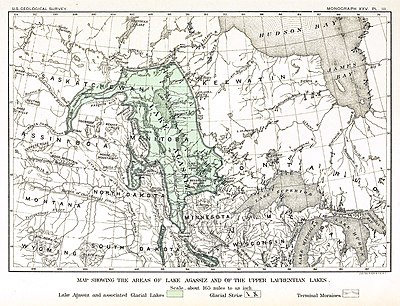Lake Agassiz

Lake Agassiz was a very large glacial lake in central North America. Fed by glacial meltwater at the end of the last ice age, its area was larger than all of the modern Great Lakes combined.[1]
The area that was covered by Lake Agassiz was the geographic center of North America. Its extent was about from 45° 30' to 55° of north latitude, and from 92° 30', on the international boundary, to 106°, on the Saskatchewan River.
Its existence was first proposed in 1823,[2] It was named in 1879 after Louis Agassiz.[3]
References[change | change source]
- ↑ Perkins S. 2002. Once Upon a Lake. Science News. 162 (18): 283–284.
- ↑ Keating, William H. (1824). Narrative of an Expedition to the Source of St. Peter's River, Lake Winnepeek, Lake of the Woods, …. Vol. 2. Philadelphia, Pennsylvania, U.S.A.: H.C. Cary & I. Lea. p. 7. From p. 7: "In some places pebbles were as abundant as if we had been travelling upon the bed of some former river or lake; the mind endeavours in vain to establish limits to the vast expanse of water which certainly at some former day overflowed the whole of that country."
- ↑ Upham, Warren (1880). The Geology of Central and Western Minnesota. A Preliminary Report. [From the General Report of Progress for the Year 1879.]. St. Paul, Minnesota, U.S.A.: The Pioneer Press Co. p. 18. From p. 18: "Because of its relation to the retreating continental ice-sheet it is proposed to call this Lake Agassiz, in memory of the first prominent advocate of the theory that the drift was produced by land-ice."
